Picturing the Early Days of Hip-Hop
Bronx legends Charlie Ahearn and Grand Wizzard Theodore discuss the rise of Hip-Hop at the Ecstasy Garage Disco.
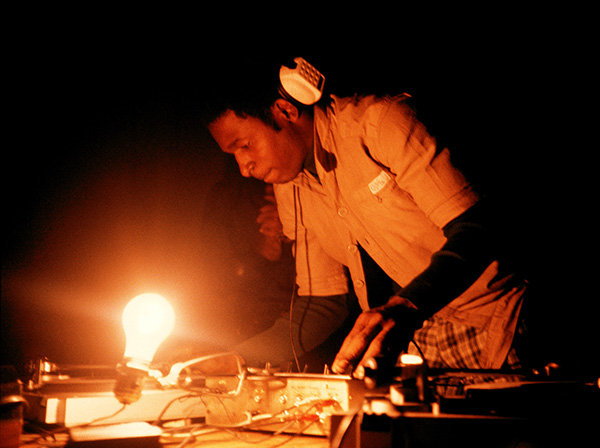
Charlie Ahearn, DJ AJ 2 from the series Scratch Ecstasy, 1980
© the artist and courtesy P.P.O.W.
Hip Hop came of age inside the cinderblock walls of the Ecstasy Garage Disco in the Boogie Down Bronx. By 1980, it was the place to be as the flyest DJs and MCs honed their skills among their peers. In tribute, filmmaker Charlie Ahearn has teamed up with Grand Wizzard Theodore, inventor of the scratch, to recreate their weekly slide show as the centerpiece of Ahearn’s exhibition Scratch Ecstasy, currently on view at P.P.O.W. Gallery. Miss Rosen, who worked with Ahearn on his 2007 book, Wild Style: The Sampler, speaks with Ahearn and Theodore about the interplay between sight and sound in the development of Hip-Hop culture during its formative years.
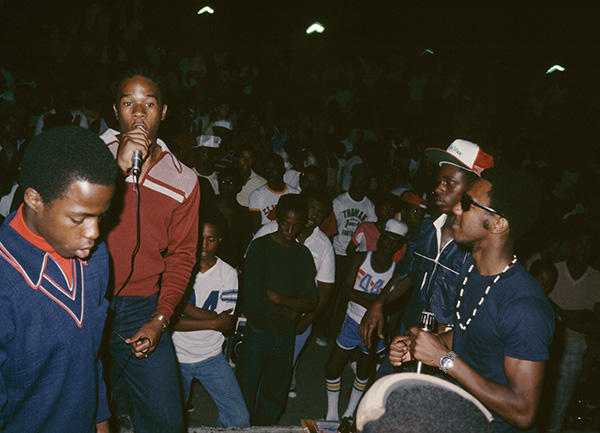
Charlie Ahearn, Funky four with Busy Bee at The Valley jam from the series Scratch Ecstasy, 1980
© the artist and courtesy P.P.O.W.
Miss Rosen: Could you tell us about the Ecstasy Garage Disco? What as the scene like?
Grand Wizzard Theodore: It was a place for groups like the Fantastic Five, the Cold Crush Brothers, and the Funky 4 + 1 to hone their craft. We had the audience so we were able to do what we loved. The Ecstasy Garage was like a gym for practicing and making ourselves better.
Charlie Ahearn: The Ecstasy Garage was like my clubhouse. It was completely dark in the room. The only light in the room was a single, sixty-watt light bulb that was over the DJ section. Listening to Grand Wizzard Theodore play music, I thought, “This is so experimental and so advanced intellectually and it’s being done by teenagers for teenagers in this really devastated place in the Bronx and nobody is playing any attention to it.”
The Ecstasy was a complete world unto itself. At some point early on, people recognized that they could do this themselves, that they could make money from it, that they could become famous from it, and that they could become stars. It was really bringing money into their households, and they had control over this. They had the means of production.
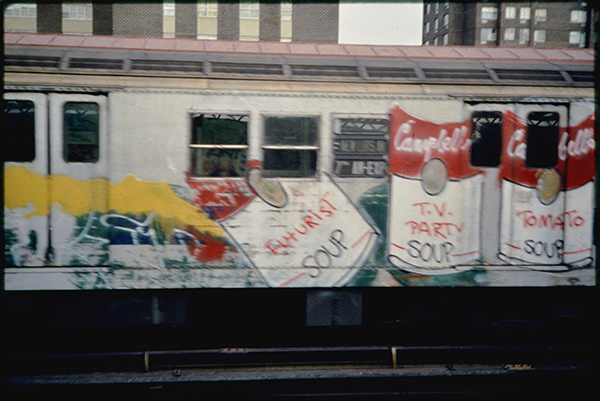
Charlie Ahearn, Fab 5 Freddy’s Campbell’s Soup Can homage to Warhol from the series Scratch Ecstasy, 1980
© the artist and courtesy P.P.O.W.
Rosen: How did you guys first connect?
Theodore: Busy Bee Starski met Charlie Ahearn and brought him around all of us. They said they were making a movie, Wild Style (1983). Once Charlie started taking pictures, we all took to him right away. We got to talk to him and he got to talk to us; we got to learn about each other and it was pretty cool. It was like, “Hey, take all the pictures you want.”
Rosen: What was the inspiration for the slide show?
Ahearn: I started bringing my slide projector stuff because I wanted to become part of the house, like the DJ. Usually I used rolls of paper on the wall behind the DJ. It was often projected as double slides and it was done as a performance. I was very inspired to see people like Kevvy Kev and Busy Bee seeing themselves up on a large screen over the DJ booth. They were superstars.
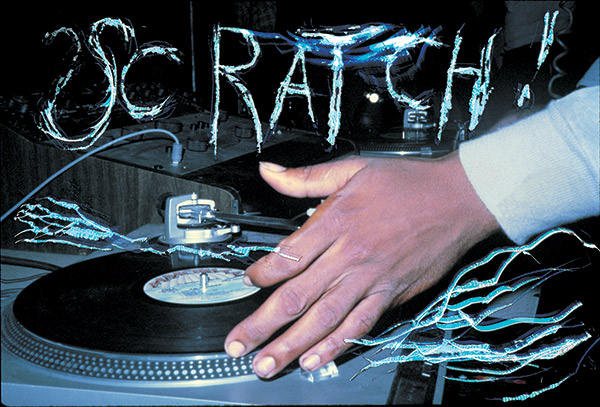
Charlie Ahearn, Scratch DJ from the series Scratch Ecstasy, 1980
© the artist and courtesy P.P.O.W.
Rosen: The slide show you made for Scratch Ecstasy opens with pictures from the original slide show, which is very meta. You were creating a social media experience for the people, taking pictures of the times and showing them.
Ahearn: The very next week! Every week I would have a couple of new rolls to add to the slide show and I would take things out that weren’t as good. I would always have shots that were either out of focus, too dark, or too bright. I thought, “This costs a lot of money. I’m going to make things out of these slides.” My idea was, “Let’s make the slides that were really bad the best slides instead of throwing them away.”
Rosen: So that’s where your version of “scratching” comes in.
Ahearn: It’s not very documentary, is it? It’s a way of saying, “Well, we’re making a show here, let’s do the best we can with what we’ve got. Let’s take these things that are not the best images but add things to them that make them really memorable.” Like the Busy Bee photo that says “ROCK ON.” It was too dark. So I scratched on it with a screwdriver on the reverse side.
Fred [Brathwaite aka Fab 5 Fredddy] and I would be sitting around talking about what we’re going to do , and I’d take out these slides and Fred would be like, “Give me one of those!”
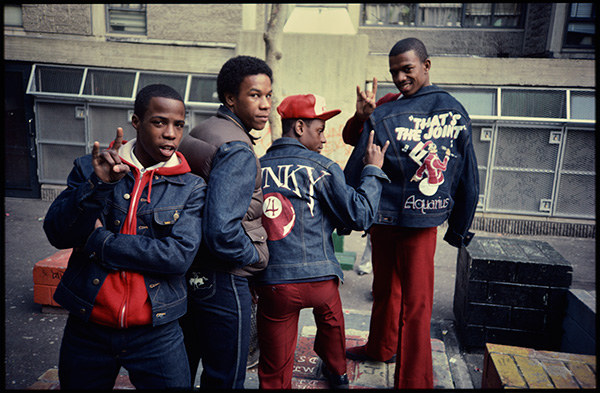
Charlie Ahearn, Funky Four in their Bronx neighborhood from the series Scratch Ecstasy, 1980
© the artist and courtesy P.P.O.W.
Rosen: How did the slide show influence the creation of Wild Style?
Ahearn: I had a stack of color Xeroxes of pictures I was taking for the movie and I would take them and pin them on the wall in order. I would go, “It opens in a subway yard and it ends over here somewhere at the amphitheater. Okay, what else is going to be in the movie?”
I’d have all these images and I wasn’t writing the script: I was creating a storyboard. The movie was to give a shine to a series of moments that people could be themselves on the film. The whole point of making the movie was to escape from plot and escape from dialogue and those other conventions of filmmaking and think of it more like a kung fu movie.
My first kung fu movie had way too much dialogue in it. [Laughs]. You don’t need all these plot points because people are in the present when they are watching the film. In a sense, it’s a series of moments when people have their two minutes where they are clearly being themselves and whatever got them in this place doesn’t matter. We’re moving through this—as you would in real life.
Rosen: The Scratch Ecstasy slide show has the same basic narrative arc as the film. We start at the Ecstasy Garage and travel through the creation and release of Wild Style. What’s it like looking back at these pictures?
Theodore: These photos remind me of where I came from, of how I grew up in the Bronx in a single parent home, gangs all around, abandoned buildings, buildings being set on fire, the city not wanting to put any money into the Bronx, all the graffiti all over the place, seeing the Bronx look like a war zone, poverty, drugs—all of this was my every day life. Seeing those pictures reminds me of how far I’ve come.

Charlie Ahearn, Rock on Busy Scratch from the series Scratch Ecstasy, 1980
© the artist and courtesy P.P.O.W.
Rosen: How did you choose the music for the Scratch Ecstasy slide show?
Theodore: I went to Charlie’s house and the first thing he did was show me the entire slide show. Then I pulled together a bunch of songs and he started to pick out the songs. He was like, “Oh wow I remember that song. We’re going to keep that one.”
Ahearn: Everything was played at the Ecstasy Garage. The songs I picked [like “Heaven and Hell is on Earth”] were made to create a feeling. There are different passages in the party and only some DJs knew this. The labels were covered and you didn’t know what was playing. The DJs wouldn’t tell you. Now everybody knows but at that time these were secret cuts. I wanted music that had this mystery to it.
I do play “Good Times” because we see Chic in the pictures and we’re going to the Roxy with Grand Master Flash. We’re not at the Ecstasy Garage anymore. We’ve entered the pop world. We’ve changed. I wanted it to be a performance by Theodore. What you hear is not edited. It’s a straight performance of the entire twenty minutes that Theodore mixed. You have to break it down to a feeling. Soundtrack is the heart of movies.
The music is by the world’s greatest musicians. You look at who’s playing on that list and you’ve got Booker T & the MGS with the organ. Is that Hip Hop? You’re damn fucking right it’s Hip Hop.
Charlie Ahearn: Scratch Ecstasy is on view at P.P.O.W. Gallery, New York through June 24, 2017.

























